NOTE: As with all guest posts, the opinions expressed below are those of the guest author and they do not necessarily represent the views of this blogs administrator and does not at all represent his employer at the Washington Institute for Near East Policy.
Jihadology.net aims to not only provide primary sources for researchers and occasional analysis of them, but also to allow other young and upcoming students as well as established academics or policy wonks to contribute original analysis on issues related to jihadism. If you would like to contribute a piece, please email your idea/post to azelin [at] jihadology [dot] net.
Past Guest Posts:
Mark Youngman, “Book Review of David Malet’s “Foreign Fighters: Transnational Identity in Civil Conflicts”,” June 20, 2013.
Hazim Fouad, “Salafi-Jihadists and non-jihadist Salafists in Egypt – A case study about politics and methodology (manhaj),” April 30, 2013.
Daveed Gartenstein-Ross and Tara Vassefi, “Perceptions of the “Arab Spring” Within the Salafi-Jihadi Movement,” November 19, 2012.
Jack Roche, “The Indonesian Jamā’ah Islāmiyyah’s Constitution (PUPJI),” November 14, 2012.
Kévin Jackson, “The Pledge of Allegiance and its Implications,” July 27, 2012.
Behnam Said, “A Brief Look at the History and Power of Anasheed in Jihadist Culture,” May 31, 2012.
Jonah Ondieki and Jake Zenn, “Gaidi Mtaani,” April 24, 2012.
Joshua Foust, “Jihadi Ideology Is Not As Important As We Think,” January 25, 2011.
Charles Cameron, “Hitting the Blind-Spot- A Review of Jean-Pierre Filiu’s “Apocalypse in Islam,” January 24, 2011.
Daveed Gartenstein-Ross, “Why Jihadi Ideology Matters,” January 21, 2011.
Joshua Foust, “Some Inchoate Thoughts on Ideology,” January 19, 2011.
Marissa Allison, “Militants Seize Mecca: Juhaymān al ‘Utaybī and the Siege of the Grand Mosque in Mecca,” June 9, 2010.
—
Turkish Fighters in Syria, Online and Off
By North Caucasus Caucus
Click here for a PDF version of this post
NOTE:
This piece provides a granular look at the backgrounds of Turkish citizens fighting in Syria, building on a recent article by Soner Cagaptay and Aaron Y. Zelin on the challenges Turkey may face in the future emanating from jihadis operating near Turkey’s southern border and the eventual return home of Turkish jihadis. While I have spent a considerable amount of time living, working and studying in Turkey, I am by no means an expert on Turkish jihadi groups or jihadi movements in general. I am a researcher on the politics of the Caucasus, but while researching foreign fighters in Syria from the Caucasus, I continually noted their engagement with Turkish jihadi material and felt it was an issue that needed further exploration.
INTRODUCTION
Over the last three decades, Turkish citizens have travelled to fight and die in conflicts both close and distant. Turkish citizens have fought in Iraq, Afghanistan (both against the Soviets and the United States), Bosnia, and the North Caucasus, sometimes occupying leadership positions in Islamist armed groups. For example, Cevdet Doger (aka Emir Abdulla Kurd) was second-in-command of foreign fighters in the North Caucasus before his death in May 2011.

Cevdet Doger and recovered Turkish identification tables, Source: sehidler.com
I will not venture to estimate how many Turkish citizens are fighting in Syria. In August 2012, Turkish journalist Adem Ozkose reported on the deaths of four Turkish fighters in Aleppo and said they were part of a group of 50 Turks fighting in that region. In the year since, it is conceivable that this number has grown along with Syria’s general population of foreign fighters.
SYRIA IN TURKISH ONLINE SPACES
There is a large amount of Turkish pro-jihadi material on Facebook relating to Syria. For example, the page, “Suriye İslam Devrimini Destekliyoruz,” (“We Support Syria’s Islamic Revolution”) has over 11,000 “Likes.” Al-Nusra Front (Nusret Cephesi in Turkish) and the Islamic State of Iraq and Sham (ISIS) both have Turkish language fan pages which are regularly shut down by Facebook but are always quickly reestablished. Turks interested in following jihadi activity in Syria are not wanting for online news coverage.
Just as Arabic-language material is translated and posted on Turkish-language sites, material from Turkish languages pages makes its way to Islamist users from other countries. For example, the pro-Islamist Turkish news website, Islah Haber, which regularly publishes news on Turkish fighter activity and deaths, uploaded an Arabic language video on 9 July 2013 that included several Turks speaking (with Arabic subtitles) about why they went to Syria. One fighter emphasized Assad’s killing of women and children and the hope of establishing a sharia-based state as a prime motivator.

The caption identifies him as “Abdullah Azzam the Turk, connected to Thughur Bilad al Sham,” Source: Islah Haber
YouTube videos are sometimes used in recruitment efforts. The Russian language website, fisyria.com, released a video on 03 July 2013 from Emir Seyfullah, an ethnic Chechen and then-spokesman of ISIS-affiliate Jaish al-Muhajirin wa Ansar. In the video, Emir Seyfullah speaks in heavily accented Turkish, calling for Turks to come help establish sharia in the land of Sham; his speech is intercut with footage of Syrian military jets on bombing runs. Jamestown’s Mairbek Vatchagaev wrote that Seyfullah is from the Pankisi Gorge region of Georgia. However, it is possible that he lived in Istanbul before the war in Syria. Many former fighters from the North Caucasus continue to live in Turkey. This has led to violence in the past, such as the September 2011 assassination of two former fighters, allegedly by Russian security services, in Istanbul’s Zeytinburnu neighborhood.

Screenshot of YouTube video about Turkish martyrs in Syria
The amount of material about Syria uploaded onto YouTube in all languages is nearly endless. However, one recent video provided insight into the extent of Turkish fighter involvement in Syria. On 05 July 2013, an account (now-deleted), associated with the Facebook page, “Suriye Devrimi Sehidleri,” (“Martyrs of the Syrian Revolution”) uploaded a video entitled, “Turkiyeli Sehidler” (Martyrs from Turkey). The video shows the images of 27 different alleged Turkish fighters killed in Syria. Some of the photos included full names, some noms-de-guerre, and others include hometowns in Turkey. The Turks in the video came from many different parts of the country, but eastern Turkey stood out, particularly Gazianatep, Diyarbakir, and Adana. The men ranged in age from as young as 17 to old men with long grey beards. Below is additional detail on three of the fighters, each case providing interesting insight into the different roles Turkish foreign fighters are playing in Syria, as well as insight into their backgrounds in Turkey.
1. AHMET ZORLU
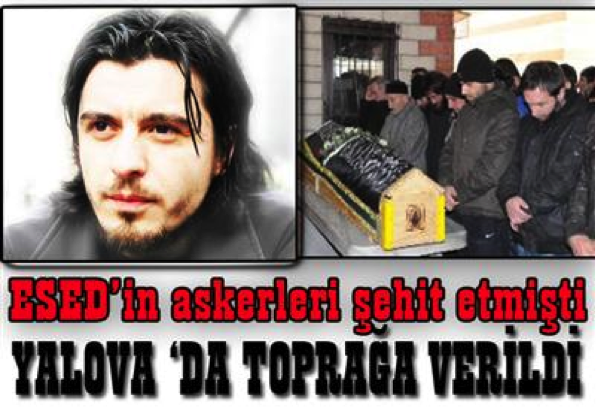
Headline from Yalova regional news website, “A martyr killed by Assad’s soldiers is buried,” Source: Bolge.com.tr
Ahmet Zorlu, with his long hair and goatee is one of the most recognizable faces on Turkish jihadi social media. Since his death, his image regularly appears in al-Nusra Front Turkish language fan pages and other pro-jihadi Turkish language media.
The 30-year-old, also known as Emir Ahmed Seyyaf, was killed along with four other Turkish fighters in an operation in Han el-Asel, near Aleppo in March 2013. Zorlu, reportedly a leader of a group of Turkish fighters, likely arrived in Syria a few months prior to the battle in Han el-Asel.
After his death, his body was returned from Syria to his hometown of Yalova, south of Istanbul on the shores of the Marmara Sea. A large funeral was held at the Yalova Central Mosque, and he was buried in the city’s cemetery. A video of the funeral can be found here. The return of the body across the border, as well as the highly visible and public nature of the funeral and burial, indicate that his “martyrdom” was not a closely guarded secret.
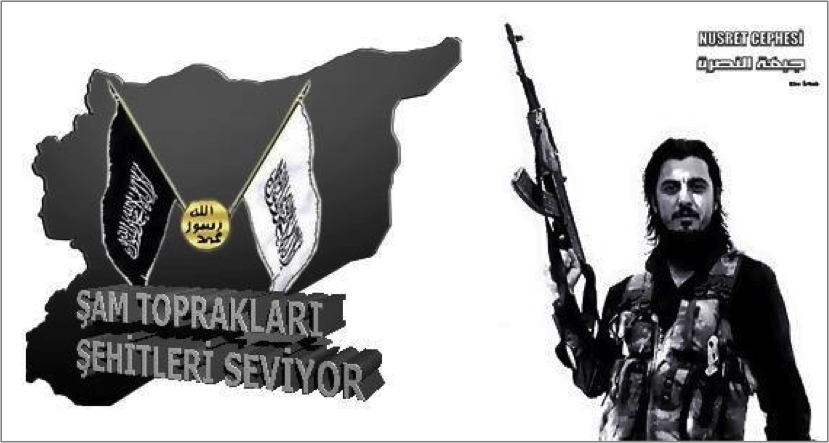
Banner photo from Turkish language al-Nusra Facebook fan page: the text reads, “The lands of Sham love martyrs.”
ABDURRAHMAN KOC
Originally from Adiyaman Province, Abudrrahman Koc is the oldest of the three men, sporting a long greying beard before he arrived in Syria. Koc was a community leader, serving as president of a religious NGO named Garip Der (Garipler Yardımlaşma ve Dayanışma Derneği or Guraba Muslims Association). As recently as June 2012, Koc spoke at a large forum organized by Ozgur Der (Freedom Association) entitled, “We Have Brothers in Prison.” Established in 2010 and based in the conservative Fatih neighborhood of Istanbul, Garip Der organized the printing and delivery of religious literature to imprisoned Muslims.
Koc arrived in Syria in early January 2013. A video of Koc, likely taken shortly after his arrival in Syria, shows him awkwardly taking target practice and discussing the beautiful weather. A sniper reportedly killed Koc during an attack on the Mengh Airbase near Azaz on 02 July 2013. A group of 12 Islamic NGOs (a list can be found here) organized prayers for Koc and other martyrs killed in Syria and Afghanistan at the Fatih Mosque in Istanbul on 07 July 2013. The general director for Ozgur Der, Ridvan Kaya, delivered a eulogy on Koc followed by a march. Marchers carried a banner bearing Koc’s face along with pictures of Zorlu and other martyrs.
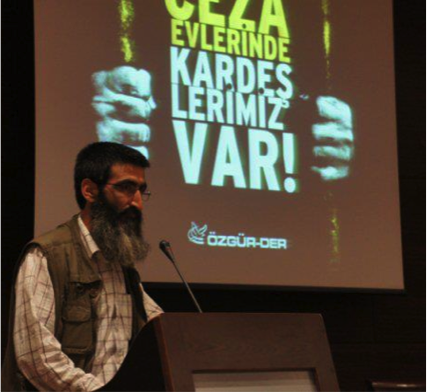
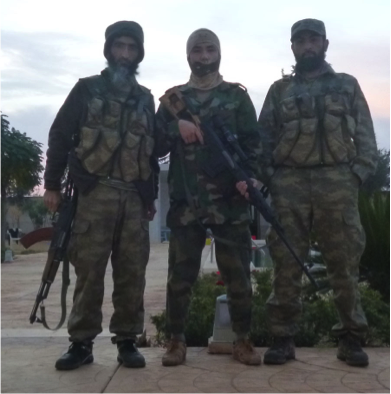
Left: Koc speaking at Ozgur Der event in June 2012, Source: Time Turk
Right: Koc (left) poses with two other fighters, Source: Haksozhaber
At least one of Koc’s associates from Garip Der went with, or followed, him later to Syria. Yakup Senatas, a Kurd from the southeastern town of Siverek was reportedly killed in Syria several weeks after Koc on 25 July 2013 also in the fighting at Mengh Airbase. Photos of the two men appeared on social media soon after Senates death. One photo at a rally in Istanbul show—Koc leading a group of protestors while Senates holds a banner.
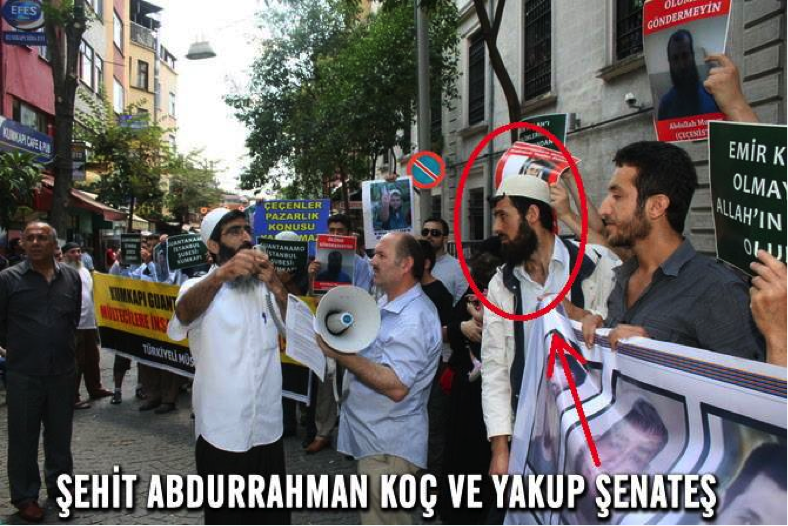
Koc (center) speaks into megaphone while Senates holds banner, Source: Facebook
METIN EKINCI
Metin Ekinci died fighting in Aleppo in August 2012. His death was initially reported on Syrian state television, where his Turkish state ID was aired along with a photo of his body. A funeral service was held in Ekinci’s native Bingol Province at the Haci Hasip Mosque, and hazsozhaber.net published the text of a special sermon given in Ekinici’s honor. Before going to Syria, Ekinci had been connected with at least one religious NGO. In November 2011, Ekinci spoke at an Izmir, Turkey-based organization, Ilim; Der (Wisdom Foundation). The content of the speech was relatively moderate and focused on basic religious issues. Ilim; Der is an Islamic research and cultural foundation. Its website produces a number of lectures with Saudi and other Arab religious figures with Turkish subtitles. The most interesting aspect of Ekinci’s martyrdom is the fact that his brother, Azad Ekinci, was one of the most wanted men in Turkey less than ten years earlier.

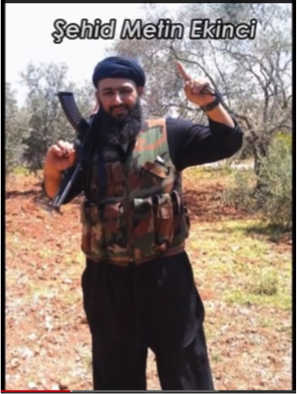
Left: YouTube video of Ekinici speaking at Ilim;Der Right: Ekinci in Syria. Screenshot is from “Turkiyeli Sehitleri” video.
Azad Ekcinci was implicated in the 20 November 2003 bombing of the HSBC building in Istanbul, part of a series of al-Qaeda linked bombings in that city which killed 57 people. He was identified as being a member of the Muslim Brotherhood and had a code name: “Abu Nidal.” It was later reported that Azad Ekinci died in a suicide attack in Iraq in January 2004, though law enforcement officials in Istanbul denied these claims.
CONCLUSION
As Zelin and Cagatay pointed out in their article, Turkey could face some serious issues as the conflict in Syria continues—concerns stemming from the uncertainty of where jihadis will turn their attention once the fight is over in Syria. Fighters’ connections to various charities and NGOs suggest at least an informal network of supporters among more conservative religious elements in Turkey. As the conflict drags on, it is likely that Turks will continue to travel to Syria to fight and establish links to the international jihadi networks that dominate the fighting in Syria’s north.
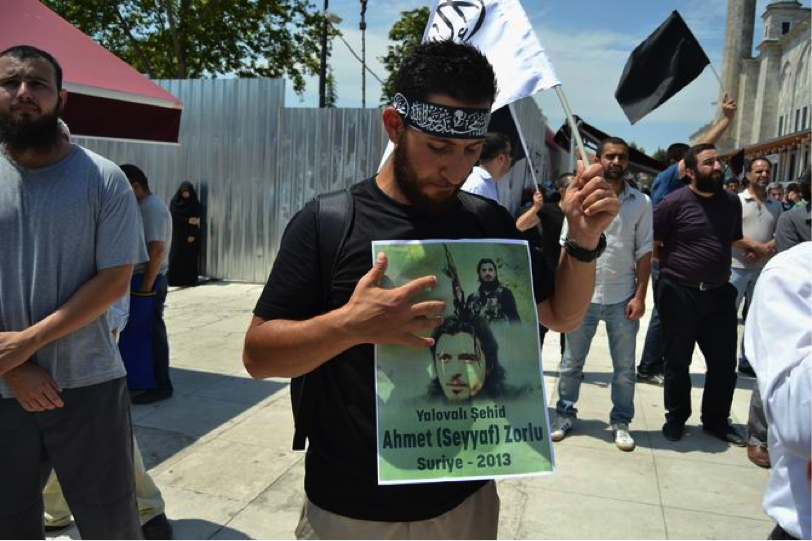
Man carries picture of Ahmet Zorlu at march at Fatih Mosque, 07 July 2013, Source: HaksozHaber
North Caucasus Caucus is written by a Washington, D.C.-based analyst. Views here are his alone. Read more at northcaucasuscaucus.blogspot.com.
GUEST POST: "Turkish Fighters in Syria, Online and Off"
Posted on

Reblogged this on pietervanostaeyen.